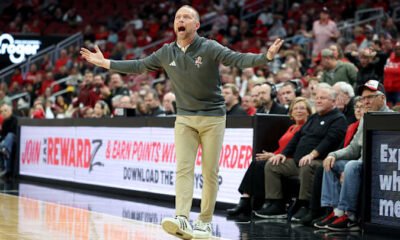Blog
Josh Oliver, a tight end, was extended by the Vikings. The $27.5 million decision made by Minnesota suggests a new offensive identity.
Breaking the Mold: How the Vikings’ $27.5 Million Bet on Josh Oliver Signals a New Offensive Identity
When the Minnesota Vikings announced a three-year extension for tight end Josh Oliver—potentially worth up to $27.5 million—they weren’t merely securing depth behind Pro Bowler T.J. Hockenson. They were declaring an evolution in offensive philosophy, one that hinges on versatility, unpredictability, and the marriage of power and finesse in the trenches.
From “Role Player” to Offensive Keystone
Josh Oliver’s journey to Minnesota began with promise at San Jose State, where he emerged as a dynamic pass-catcher. Drafted in the third round by the Jacksonville Jaguars in 2019, he flashed receiving ability but struggled to carve out a consistent role, bouncing between the Jaguars and Ravens before landing in Minneapolis in 2023. Initial assessments pegged him primarily as a blocking specialist—an unglamorous but vital cog in a ground-first scheme .
However, the Vikings’ decision to lock him up through 2028 suggests they see untapped potential beyond lead-blocker status. “One of the things we wanted was a theme of versatility,” noted General Manager Kwesi Adofo-Mensah, “somebody like Josh Oliver who can actually make Justin Jefferson better. You’ll see it when Kevin [O’Connell] talks and see how we play” . Minnesota didn’t invest mid-tier tight end money just for extra road grunt; they invested in the promise of Owen’s hybrid skill set.
Anatomy of the Extension
Officially announced June 10, the Vikings’ press release held few surprises: Oliver’s extension runs three years through 2028, with undisclosed terms. The financial contours emerged in reporting by ESPN (via Athletes First), which pegged the deal at a base of $23.25 million, with escalators pushing the ceiling to $27.5 million. Of that, $11.9 million arrives as new guarantees, bringing his total guarantees with Minnesota to $19.9 million .
For context, Oliver entered the extension year of a three-year, $21 million deal signed in 2023. In both 2023 and 2024, he posted identical receiving lines—22 catches each season—and set a personal best with three touchdowns in 2024. Over 67 career games (37 starts), he has amassed 70 receptions for 701 yards and seven scores . While those numbers hardly light up the highlight reel, they underscore steady, if unspectacular, production.
A Strategic Shift toward 12 Personnel
Under Head Coach Kevin O’Connell—along with Offensive Coordinator Wes Phillips—the Vikings’ offense flirted with the Sean McVay tree’s modern wrinkles: pace, spacing, and heavy shotgun formations. Yet in 2022 and 2023, Minnesota ran 11 personnel (one RB, one TE, three WRs) on over 80% of snaps, leaving defenses free to crowd the box and challenge the running game .
Now, by investing in a second capable tight end, the Vikings can integrate 12 personnel (one RB, two TEs, two WRs) at will. “We feel like one of the ways we can help Jefferson is by using our two-tight end package,” Phillips explained, “to apply pressure to the defense because they’ve got to defend all the different variations of formations and ways you can take advantage with some of those bigger groupings early downs” .
This alignment offers multiple benefits:
- Enhanced Run Blocking: Oliver’s proven skill at sealing edges escalates the effectiveness of inside runs and stretch plays.
- Mismatches in the Passing Game: When defenses counter two-TE sets by inserting extra linebackers or safeties, Justin Jefferson and wideouts gain one-on-one opportunities. Conversely, Oliver’s 6’5”, 259-pound frame can bully smaller defenders in traditional alignments.
- Pre-Snap Flexibility: Motion and shifting Oliver across formations force safeties to reveal coverage intentions, allowing Kirk Cousins to diagnose mismatches and adjust protections.
Balancing the Run and Pass
The 2024 Vikings offense finished 10th in yards per game (349.3) but barely cracked the top half in rushing (112.1 yards/game, 17th overall). Even with Dalvin Cook’s consistency and Aaron Jones’s midseason spark, box defenders often keyed on Jefferson and Hockenson—facilitating schematic resistance .
Oliver’s arrival signals a renewed commitment to balance. By bolstering the blocking front, Minnesota hopes to reclaim early-down dominance and set up favorable passing downs. As Hockenson underscored, “Josh is one of those guys who, once he gets his hands on you, it’s kind of, ‘Good luck’” .
Moreover, the tweak could mirror successes in Washington (with Jordan Reed and Vernon Davis) and in recent Rams squads (with Tyler Higbee alongside Gerald Everett), where misuse of two-TE packages created defensive headaches.
Beyond the Trenches: Untapped Receiving Upside
While his blocking merits center stage, Oliver’s receiving roots cannot be ignored. At the Combine, he clocked a 4.62-second 40-yard dash—impressive for his size—and showcased soft hands during route drills . With Hockenson commanding primary coverage from linebackers and big corners, Oliver could sneak into soft spots underneath.
Wes Phillips, himself a former tight ends coach, stressed that perceptions can lag reality: “Coming out [of college], he was really more of a pass-catcher. We’ve been impressed with the continuity and ability there” . In two-TE sets, Cousins could dial up seam routes, shock plays, or even occasional play-action look-off throws—turning Oliver from an in-line blocker into a secret weapon.
Financial Prudence in a Cap-Strapped Landscape
Despite the headline number, the extension reflects cap management savvy. The $8.2 million cap hit in 2025 represents just half of the annual average—manageable for a team already invested heavily in its offensive skill group . By structuring guarantees and bonuses judiciously, Minnesota retains financial flexibility to chase midseason reinforcements or accommodate unforeseen raises for Jefferson, Hockenson, and Cousins down the road.
A Cultural Signal: Grit, Versatility, and Team-First Ethos
Perhaps the most profound message of Oliver’s extension lies beyond formations and finances. His own narrative—from fringe prospect to reliable teammate—echoes the Vikings’ desired identity: hard-nosed, adaptable, and collective. Oliver’s humility in embracing a “dirty job” role, and the coaching staff’s faith in his broader skill set, fosters a culture where any player can transcend labels through work ethic and preparation.
That mindset resonates in a locker room keen to balance superstar pursuits with unglorified efforts—mirroring how blocking tight ends like Zach Ertz or Tyler Higbee once underpinned Super Bowl runs. By doubling down on that archetype, Minnesota stakes its offense not only on talent but on a team-first blueprint built to grind out opponents.
Looking Ahead: Potential Breakout and Tactical Evolution
As the Vikings enter OTAs and training camp, all eyes will focus on how often and in what roles Oliver snaps the ball. Will he line up inline, flexed out, or motion into the backfield? Can the offense sustain two-TE formations on 1st-and-10 without telegraphed intents? And crucially, can Oliver blossom as a receiving threat under Cousins’s mid-field ingenuity?
If early reports on his grasp of the playbook hold true, expect Minnesota to roll out packages that:
- Pair Oliver with Hockenson in jumbo sets, then split them to isolate 1-on-1 coverage near the numbers.
- Use play-action off power runs that leverage Oliver’s blocking to freeze linebackers before seam shots.
- Incorporate shuttles and shovel passes to the flat, exploiting Oliver’s blocking reputation to lure safeties out of position.
Should any of these wrinkles consistently yield positive outcomes, the Vikings’ offense could shift from good to dynamic, blending the run-pass dialectic into a seamless threat.
Conclusion
Josh Oliver’s three-year, $27.5 million extension is far more than a depth move. It is a strategic proclamation: Minnesota intends to forge a multifaceted attack built on blocking prowess, schematic flexibility, and hidden offensive weapons. By embedding Oliver at the heart of its plans, the Vikings take a decisive step toward rejuvenating their running game, diversifying their personnel packages, and unlocking mismatches that elevate every playmaker around him.
In an NFL landscape where innovative offenses often hinge on tight ends who can both maul defenders and snatch contested catches, Oliver’s evolution could mark the turning point for a Vikings unit eager to reclaim NFC supremacy. As the pads come on and the season looms, all eyes will turn to whether this calculated investment reshapes Minnesota’s identity—transforming Josh Oliver from an overlooked role player into the linchpin of a new offensive era.
-

 Blog5 months ago
Blog5 months agoPat Kelsey sends a strong three-word fiery message to the Louisville basketball’s team after their Cardinals 14th win…
-

 Blog7 months ago
Blog7 months agoNetflix releases “The Underdog,” a much-anticipated documentary about Drew Brees. slated for publication on the 25th
-

 Blog5 months ago
Blog5 months agoMikaela Shiffrin responds to cross-country skier Jessie Diggins’ letter following her failure to secure a solitary podium finish at the FIS Nordic Worlds
-

 Blog3 months ago
Blog3 months agoBehind the Turns: Netflix’s Upcoming Documentary on Mikaela Shiffrin’s Fights, Fears, and Love
-

 Blog4 months ago
Blog4 months agoLegacy Tour Led Zeppelin has officially confirmed their 2026 reunion tour, which will be their first extensive live performances since 2007. The “Led Zeppelin Legacy Tour 2026” will begin on June 10, 2026, at Los Angeles’ SoFi Stadium.
-

 Blog5 months ago
Blog5 months agoWomen’s Slalom Run 1 at the FIS Alpine Skiing World Cup: Are
-

 Blog5 months ago
Blog5 months ago“Courtside to Aisle-Side: Tyrese Haliburton and Jade Jones Set New Wedding Date”
-

 Blog7 months ago
Blog7 months agoFederica Brignone: “I’m fine, but my return to skiing is far off.”
